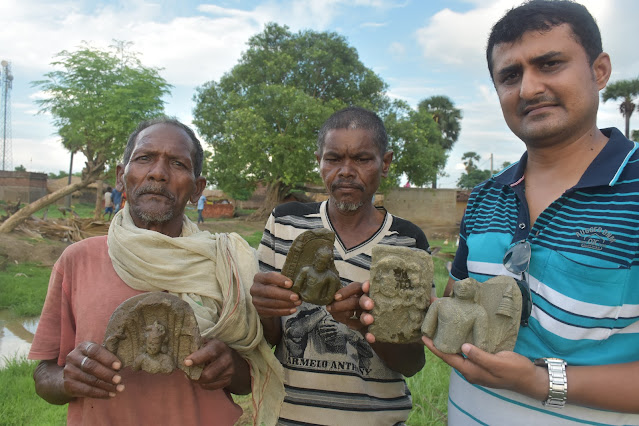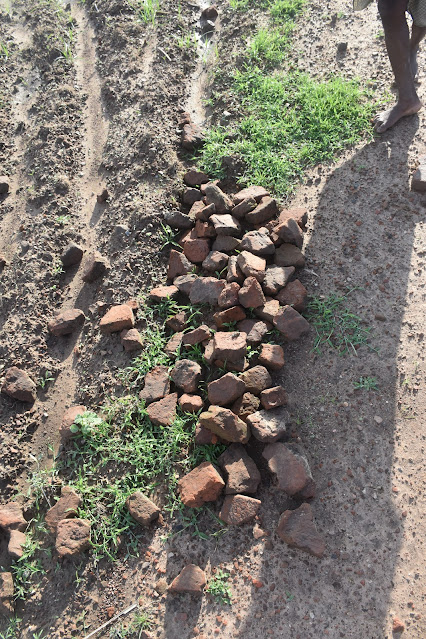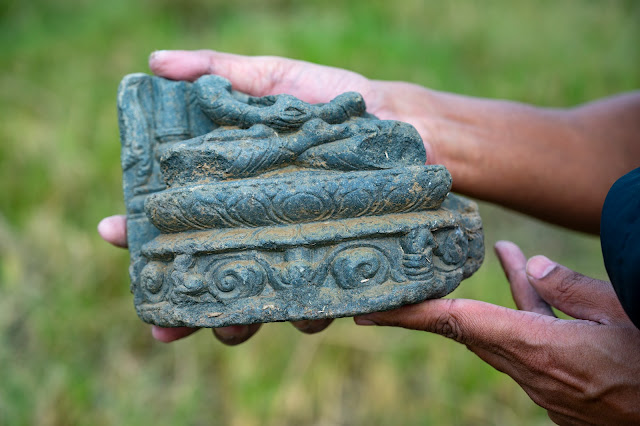 |
| Broken images of the Buddha and Bodhisattva. Gāfā Kalān. Pic@ Vikash Kumar. |
Xuanzang (Hsüan-Tsang, 602-664 CE) in his travelogues referred to his visit to the site of the hermitage of Udraka Rāmaputra (Uddaka Rāmaputta). Uddaka Rāmaputta was a sage and teacher of meditation based in Magadha (J.i.66, 81). The interactions between Uddaka and Bodhisattva Siddhārtha (Buddha-to-be) are well documented in all early biographical texts like Mahāvastu (2nd BCE-4th CE), Lalitavistara (3rd CE), Buddhacharita (2nd CE), Nidānkathā (5th CE?) and Abhinishkramana Sūtra (6th CE).
In quest of the Truth, Prince Siddhārtha left Kapilavastu in the middle of the night, removing his princely clothes and putting on monk’s robes. With his sword, he cut his long hair, took a begging bowl, and travelled to various places before he reached Rājagṛiha. After a brief stay at Rājagṛiha, he promised King Bimbisāra that he would return once he realised the Truth. He then practised under two hermit teachers, Āḷāra Kālāma and later, Udraka Rāmaputra. Udraka taught the Bodhisattva Siddhārtha a meditational practice leading to a state of trance known as ‘neither perception nor non-perception,’ a condition of pure awareness devoid of any perceptual experience. Bodhisattva Siddhārtha quickly mastered this technique of meditation. Therefore, Udraka offered Bodhisattva to become his student, however, the Bodhisattva had to refuse the offer, his teachings and the cult - as Udraka's technique led to a form of liberation which was temporary in nature wherein the sufferings would arise again (M.i.165ff., 240ff.; DhA.i.70-1). Bodhisattva Siddhārtha was on a quest to find an eternal solution for Dukkha (suffering). Finding no fundamental answer to his questions via this method, he eventually left Rāmaputta and turned to the practice of austerities.
Later, Bodhisattva Siddhārtha moved to the vicinity of the village Bakraur, historically known as Senānigāma in Uruvelā, to practice austerities in isolation. For the next few years, Siddhārtha undertook strict ascetic practices, such as extreme fasting, without food and water. According to legend, on the day of Veshākha Pūrṇimā, Siddhārtha sat in deep meditation under the Pipal tree (later known as the Bodhi Tree), where Bodhisattva attained enlightenment and became the Buddha, the Awakened One.
 |
| Gautama Buddha meets the ascetic Uddaka Rāmaputta (left), Borobudur Temple Compounds 8th and 9th century, first corridor, main wall. @wikimedia |
 |
| Map-1. Map depicting villages Gāfā Kalān and Nāmā. |
Following his enlightenment, the Buddha moved around the Bodhi Tree and devoted himself to his perfection. Buddhist literature tells us how the Buddha was reluctant to teach the Dhamma to mankind because his findings were subtle and profound which he believed would be difficult for ordinary men to grasp in its true form. Knowing the Buddha's dilemma, the deity Brahma Sahampati appeared before the Buddha when he was meditating under the Ajapālanigrodha (Vin.i.5-7). Brahma Sahampati persuaded and convinced the Buddha that he needed to stay in the lokiya (material) world and spread the Dhamma to mankind. The Buddha then realised that it was not appropriate for him to enter nibbāna (nirvāṇa) at this moment. This is how the most compassionate Buddha decided to stay in this lokiya (material) world to teach and spread the Dhamma among humanity in order to free themselves from their Dukkha (sufferings). Having decided to teach the Dhamma the Buddha asked himself ‘To whom shall I first teach the Dhamma?’ The Buddha thought highly about his previous teachers Ālāra Kālāma and Uddaka-Rāmaputta. He thought Ālāra Kālāma and Uddaka Rāmaputra would be ideal but with his divine vision, he discovered that both of them had recently died (Vin.i.7).
 |
| An aerial view of Nāmā Dih on the banks of river Paimār. Pic@ Shantu Simple. |
 |
| Heritage Volunteer Jackie Vishwakarma with villagers, holding broken images. Nāmā. |
 |
| Broken Images of Buddha and Buddhist deities. Nāmā. |
 |
| The mound of Nāmā Dih visible at a distance. |
 |
| Ancient Brickbats at Nāmā Dih. |
 |
| An aerial view of Gāfā Kalān. Pic@ Shantu Simple. |
 |
| A broken image of Buddha. Gāfā Kalān. Pic@ Vikash Kumar. |
 |
| A broken image of Buddhist deity. Gāfā Kalān. Pic@ Vikash Kumar. |
 |
| A broken image of Buddha. Gāfā Kalān. Pic@ Vikash Kumar. |
 |
| A broken image of Buddha. Gāfā Kalān. Pic@ Vikash Kumar. |
More than one thousand years later Xuanzang visited the site where stood the hermitage of Uddaka Rāmaputta. Surprisingly, Xuanzang in his accounts has not mentioned the tale of the link between Uddaka and Buddha which is widely documented in the early Buddhist texts like Buddhacarita (Willemen 2009: 88-89), Mahavastu (Jones 1952), Abhiniskramana Sūtra (Beal 1875: 176-177, 243) etc. A question arises, what could be the reason for this missing account of the most significant encounter from the Buddha's life? Is the tale associated with encounters of Uddaka with the Buddha corrupted through time? A similar incident occurred when the Buddha and King Bimbisāra met for the first time. According to early Buddhist literature, King Bimbisāra welcomed the Buddha during his first visit to Rājagṛiha after his great awakening at Laṭṭhivanuyyāna. But Xuanzang records that this incident occurred near Nālandā (Anand 2024). As Xuanzang visited these sites in the 7th CE, that is more than a thousand years after the Buddha's Mahāparinibbāna in the 5th BCE; it is fair to deduce that many traditions and tales were twisted or omitted by his time.
Furthermore, biographical texts have different versions of where Siddhārtha met Uddaka. Mahāvastu mentions it was Rājagṛiha (Jones 1952:119). According to the Abhiniskramana Sūtra the meeting place was ‘not far from Rājagṛiha’ (Beal 1875:176). As per the Lalitavistara, Siddhārtha met Uddaka when he later arrived in Rājagṛiha with a large group of seven hundred of his students. Lalitavistara suggests that the hermitage of Uddaka was at some different place than Rājagṛiha. As per Xuanzang, the Uddaka place was situated east of the seats of the four past Buddhas, in a dense forest on the other side of river Mahā (Rongxi 1996: 231)/Moha (Watters 2004:141). The site related to the four past Buddhas was located to the east of the Bodhi Tree and across the Nairañjanā River. Xuanzang saw a stone pillar (Ashokan?) near the seats of four past Buddhas (Rongxi 1996: 231). Francis Buchanan Hamilton (1762-1829) in his surveys of districts of Patna and Gaya in 1811-12 noted the existence of a stone pillar at Koteni Bakraur mound (now known as Sujātā Stūpa). Buchanan noted that the stone pillar was removed from Bakraur by Mr Boddam to Sahibganj (in Gaya) (Buchanan 1925:55). Therefore, based on the reference of Xuanzang we should look for the site of Uddaka east of the present-day village of Bakraur on the other side of river Mohāne (ancient Mahā/Moha).
Rāmaputta was a popular and well-respected teacher with a large number of students. In the Vassakāra Sutta of the Anguttara Nikāya (ii.180) it is mentioned that King Eleyya, together with his bodyguard, Yamaka, Moggalla and others, were followers of Rāmaputta and that they held him in great esteem. The Kassapa brothers, Uruvelā, Gayā and Nadī, the popular fire-worshiping ascetics, contemporaries of Uddaka, who had large followings similar to Uddaka had their hermitages on the banks of river Nairañjanā. Similarly, Bodhisattva Siddhārtha (Buddha-to-be) chose the banks of the river (Nairañjanā) for his penance practices. Therefore, I am of the view that the hermitage of Uddaka as well should be located on the banks of some river.
The shrine of Uddaka according to Xuanzang was east of Mohā (Mohāne). The first river that we meet on the east of Mohāne is Paimār. Paimār River is located 6 km as the crow flies from Bakraur. Also, Paimār is a perennial river which emanates from the Vindhya range on the south and takes a winding path through the plains of Magadha, merging with other rivers before finally meeting the Ganges in the north. I have identified two villages Gāfā Kalān (24° 40' 55'' N. 85° 05' 15'' E) and Nāmā/Nawān (24° 42' N. 85° 04' E) that seem to be potential sites for the hermitage of Uddaka mentioned by Xuanzang (refer to Map-1). Gāfā Kalān and Nāmā are situated on the western banks of river Paimār. Both villages are settled on ancient mounds. There is a prominent mound called Nāmā Dih (24° 42' 04'' N. 85° 04' 33'' E) situated 500mt east of village Nāmā on the immediate banks of river Paimār (refer to Map-1). The mound is spread over 15 acres and is around 7ft raised from the neighbouring fields. I have a hunch, that one of these two villages represents the remains of Uddaka's hermitage visited by Xuanzang. Ancient images of Buddha and Boddhisattvas were found mauled in the village collectives which were further located outside the village periphery of Gāfā Kalān and Nāmā. In my more than 15 years of expedition in villages of Magadha, I have witnessed many such village collectives comprising images that seemed to be objectively demolished with the intent of ruining an ancient tradition. I sometimes wonder, who were these people who had such a strong disdain for the Buddha.
Xuanzang saw a pillar at the site of Uddaka. I have not found any trace of the pillar mentioned by Xuanzang in Gāfā Kalān or Nāmā. I think the very people who mauled the images of Buddha may have also destroyed the Pillar into pieces. Maybe a Ground Penetrating Radar (GPR) study in Gāfā Kalān and Nāmā in the future could help reveal the complete truth. But what is important is that the site of Uddaka was marked with a (Ashokan) Pillar. This means just as Buddha held Uddaka in admiration the later traditions including King Ashoka venerated Uddaka Rāmaputta.
The story is chronicled by Deepa Nandi.
Bibliography:
Anand, D. (2024, March 21). Xuanzang and shrines of Sāriputta, Moggallāna and Mahākassapa around Nālandā. [Blog post]. Available from:
https://nalanda-insatiableinoffering.blogspot.com/2024/03/xuanzang-and-shrines-of-sariputta.html [Accessed 21st March 2024]
Beal, Samuel.; 1875, The romantic legend of Sākya Buddha: from the Chinese-Sanscrit, A translation of the Chinese version of the 'Abhinishkramana sūtra', done into that language by Djnanakuta. London: Trübner & Co.
Bigandet, Right Reverend P.:1880, The Life of Legend of Gaudama: The Buddha of the Burmese, Vol I. London: Trübner & Co.
Buchanan, Francis; 1925, Journal of Francis Buchanan, Patna and Gaya, Edited with Notes and Introduction by V.H. Jackson, Published by Superintendent, Government Printing, Bihar and Orissa.
Childers, R. Caesar., Davids, C. A. F. Rhys (Caroline Augusta Foley Rhys)., Davids, T. W. Rhys (Thomas William Rhys).; 1925. Buddhist birth-stories (Jataka tales): the commentarial introduction entitled Nidāna-kathā, The story of the lineage. New and rev. ed. London: G. Routledge.
Dharmachakra Translation Committee (tans.).; 2013. Lalitavistara. Published by 84000. www.84000.co
Jones, J.J. (trans.); 1952, The Mahāvastu, Vol.II. London: Luzac & Co.
Rongxi, Li.; 1996, The Great Tang Dynasty Record of the Western Regions. California: BDK America, Inc.
Willemen, Charles; 2009, Buddhacarita: in praise of Buddha's acts: (Taishō volume 4, number 192) by Aśvaghoṣa. Berkeley, CA: Numata Center for Buddhist Translation and Research.
Watters, Thomas.; 1905, On Yuan Chwang’s Travels in India. Edited by T. W. Rhys Davids and S.W. Bushell. Vol. II. London: Royal Asiatic Society.
Abbreviations of Bibliography:
Source of Pāli references: http://www.palikanon.com/english/pali_names/dic_idx.html
P.T.S. Means published by the Pāli Text Society.
SHB. Means published in the Simon Hewavitarne Bequest Series (Colombo).
DhA. Dhammapadatthakathā, 5 vols. (P.T.S.).
J. Jātaka, ed. Fausboll, 5 vols.
M. Majjhima Nikaya, 3 vols. (P.T.S.)
Vin. Vinaya Pitaka, 5 vols., ed. Oldenberg (Williams and Norgate).
No comments:
Post a Comment